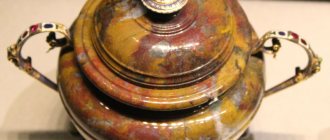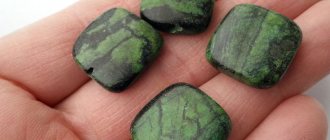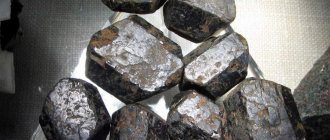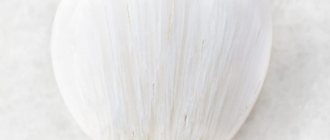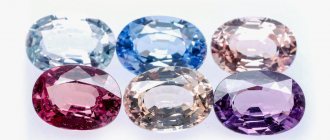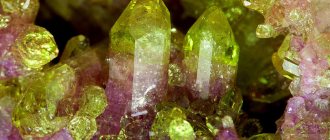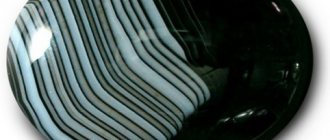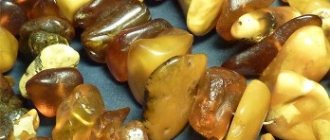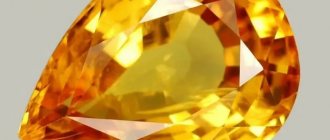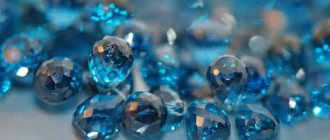Jasper is a semi-precious ornamental gem. The English version of the name is Jasper. The origin of the name comes from the Greek word “ἴασπις” (motley, speckled stone). An obsolete version of the name is jasper.
Origin of the name jasper stone
The history of the origin of jasper has not been fully explored. Many peoples called this stone in their own way, but none of them are in tune.
It is believed that the names of the stone in different nations come from the Greek language, from the word Yatro, which translates as “I heal”, “I heal”.
According to another version, the name comes from the Chinese name for jade stone, which is pronounced “Yushi”.
- In eastern countries, jasper was called Ieshme.
- In Persia the stone was called Jasper.
- In Afghanistan, jasper was called Yashai.
- The Greek name of the stone is Jasper, which is absolutely identical to its name in English - Jasper, and is literally translated into Russian as Jasper.
Jasper or jasperoid?
E. Kievlenko, a connoisseur of gems, classifies jasper as “metamorphosed, primary sedimentary siliceous, variegated in color, hard, opaque rocks composed of quartz with an admixture of chalcedony. Geological dictionaries specify that the rock is of volcanogenic-sedimentary or organogenic origin.
Ural geologists (they also have maps in their hands) distinguish:
- Actually jasper. These include siliceous organogenic rocks born from marine radiolarian oozes.
- Jasperoids. Rocks formed from volcanic siliceous material from an ancient sea.
- Jasper-like rocks.
Expert opinion
Semenishcheva Polina
Specialist in mineralogy. Graduated from St. Petersburg Mining University.
Mineral Lovers : Red, yellow, green and brown chert spherulites are found in Santa Clara County. They were called parrot jasper. But still it is flint.
Jasper mineral: properties, composition and description, textures
Jasper photo
People have long paid attention to this multi-colored mineral. The characteristic of its appearance lies in the name itself. The meaning of jasper is “Jasper” translated from Greek means “variegated”. And indeed, looking at the gem, what strikes you first is the variety of shades. This play of colors is easy to explain.
What is jasper?
It belongs to a metamorphic rock, which is a whole set of minerals such as quartz, chalcedony and others. Under the influence of high temperatures, the crystals are compressed, and the presented rock is formed, which has an unusual color.
The ancient name of jasper fully characterizes the mineral. In Rus', a variegated gem was called “speckled.” Large deposits were discovered in the Urals and Altai Territory. Almost immediately the breed found application in interior decoration and the production of household products.
Giant blocks made it possible to create unusual works of art. An excellent example is the Queen of Vases, located in the Hermitage. Made from a green-wavy gemstone. The giant bowl reaches 5 meters in diameter and weighs about 19 tons.
Due to the heterogeneous composition of impurities, the stone is characterized by a variety of shades. The degree of variegation of a mineral depends on the presence of impurities.
The inclusions create unusual patterns and make the structure of the mineral heterogeneous. Almost monochromatic gems of this type are very rare.
The silicon rock that forms the basis of the mineral is quite strong. Jasper stones are opaque.
Chemical composition of jasper
The main part is silicon oxide (SiO2), sometimes the content of this component reaches 95%. Aluminum oxide (Al2O3) and iron oxide (Fe2O3) are found in different proportions, reaching 10-15%. Calcium oxide (CaO) within 5%. The remaining components constitute a mass fraction of less than 1%.
Jasper textures
The mineral has a large number of possible textures, we list the main ones:
- curled;
- massive;
- banded;
- breccia;
- spotted;
- speckled;
- tape.
Each texture is good in its own way and can have different prices. It is worth noting that the variegation of the stone is almost obligatory; monotonous specimens are very rare. Of course, in some cases they are more expensive than variegated ones due to their rarity.
Appearance and properties
This natural stone is a variety of chalcedony, which belongs to the oxide class (IMA class), belonging to the chalcedony group. Chemical formula (in general) – SiO2. The bulk of the rock is quartz (chalcedony). Jasper contains many impurities (up to 20%). These include: chlorite, hematite, mica, feldspar, actinolite, epidote, pyrite, oxides and hydroxides of manganese and iron, porphyries, which are unevenly distributed. Approximate content of the main elements:
- silicon dioxide – 80-95%;
- aluminum and iron oxide – up to 15%;
- calcium oxide – from 3 to 6%.
The mineral does not dissolve in acids, but is etched with hydrogen fluoride. Not resistant to alkalis. Under the influence of temperature, it loses color and cracks.
There are any shades of crystals, depending on the impurities included in the composition. Most often it is colored reddish-brown (due to the presence of iron and hematite), yellow variants are also common. Specimens of blue shades are quite rare. Solid-colored gems are much less common than striped, spotted, or other-patterned gems.
This stone has the following characteristics:
| Parameter | Description |
| Opening year | Unknown |
| singonia | Trigonal |
| Hardness | 6,5-7 |
| Type | Uniaxial |
| Density, specific gravity | 2.58-2.91 g/cm³ |
| Selection form | Microcrystalline aggregates, in the form of lenses, veins, clusters, layers up to several hundred meters thick, with a short horizontal length |
| Maximum birefringence | No |
| Stroke color | White |
| Solubility | Dissolves under the influence of hydrogen fluoride and alkalis |
| Cleavage | Absent |
| Refractive indices | nω = 1.543–1545 nε = 1.552–1.554 |
| Shine | Frosted, glass |
| Transparency | Completely opaque, even in thin chips |
| Typical impurities | Al, Fe, Mg, Ca, Cl, S |
| Kink | Conchoidal |
Varieties
The classification of jasper is presented as follows:
- Striped (tape) options are one of the most common. In structure and crystallization it is close to jasper-shaped quartzites. They are distinguished by the presence of alternating layers of different tones. The width of each “ribbon” ranges from a couple of millimeters to several centimeters. The layers differ not only in color, but also in the composition of the rocks. This type of jasper includes:
- Revnevskaya. Painted in various variations of green, sometimes gray. The color and pattern make it look like malachite. Light lines, as a rule, consist of quartz combined with albite; there is also a small amount of actinolite, epidote, feldspar, and clinozoisite. The dark layers are formed predominantly of feldspar, with an admixture of quartz, diopside, epidote, and sphene.
- Kushkuldinskaya. A bluish-brown variety with thin green stripes consisting of chlorite and celadonite.
- Tashaulskaya. Bright green jasper with stripes of varying tones. Mainly composed of chalcedony, pyrite is present, the light lines are formed by chlorite and pumpellyite.
- Staromynakovskaya. The stone alternates bright green and crimson lines. Contains Piedmontite.
- Safarovskaya. Dark brown layers are formed by pyrite and hematite, adjacent to reddish-brown layers.
- Variegated jaspers. They have a combination of different patterns in a small space of stone - stripes, spots, hemispheres, rings, all of them can be outlined or vague.
The most impressive specimens are those with a dark background and a contrasting pinkish, beige or red pattern on it.
They belong to recrystallized rocks. Grain sizes range from hundredths to tenths of a millimeter. They mostly consist of quartz; the presence of hematite, garnet, magnetite is also noted; the proportion of the compound, as well as the presence of other inclusions, is determined by the specific deposit. Based on the type of drawing they are divided into:
- Brecciated and brecciated. It consists of a clastic base and vein quartz cementing it. The brecciated texture is characterized by the absence of a pronounced boundary between the two layers. Deposits are found in zones of silicification and crushing.
Calico. Most of the rock is micrograined, less often glassy; against this general background there are zones of quartz with a coarse-grained structure or fibrous chalcedony. Such areas have the appearance of veins, streams, lenses, spots of different colors.
- Concentric. This type is characterized by a pattern in the form of rings, hemispheres, spots formed by garnet and having a porcelain-white or pinkish color, often described as “fish scales”. They are located against a background of fine-grained quartz of a dark tone. A typical representative is Orsk jaspers.
- Fluid (or streamy). The bulk of the rock is formed by quartz; it contains magnetite, hematite, and plume-type garnet deposits.
- Spotted. Characterized by the presence of small rounded zones of dark color, having different diameters.
- Homogeneous species. They do not have a pronounced pattern; the tone of the rock is almost the same throughout. They differ from other types in that they are practically not affected by recrystallization. Under high magnification, homogeneous jaspers have a noticeable spectacle structure, which consists of round or elongated eyes from 0.1 to 0.4 mm, formed by coarse-grained quartz, sometimes in combination with chalcedony, opal, and chlorite. Most often in different shades of red, all options have an unexpressed color. They are rare, have pronounced cracking, and are not used in jewelry.
- Irnimit. The main background of gems is cherry or orange with a gray tint. It contains spots and veins of a bright blue tone, up to almost black, in a chaotic order. In addition to the main components, it contains manganese and alkaline amphibole.
- Jasperoids. The composition is supplemented with iron, less often hematite, and does not contain garnet. They are a massive post-volcanic formation formed by microfibrous chalcedony. Has varieties:
- Jasper-agate. A transitional option between these two minerals. Typically gray, yellow or brown, specimens may be uniform or contain stripes or spots.
- Jasper-spherophyre. More homogeneous in structure than the previous version. They have a yellow tint due to the limonite content, and there are stripes, clearly or indirectly outlined.
- Jasper-like quartzites. The structure of quartzites differs from jasper in coarse grain, greater recrystallization, strong fracturing, and the presence of a large amount of ore impurities. They can be uniform in texture, or spotted or striped.
- Jasper-like rocks. The composition contains potassium feldspar, chalcedony or quartz. They are formed under the influence of post-volcanic processes, as well as regional-metaphorical, contact-metasomatic ones. The result is a rock containing large amounts of chlorine, calcium carbonates, magnesium and iron. Varieties:
- Tuffs. Homogeneous minerals with a fine-crystalline structure. They can be yellow, green, lilac, brown, pink, including striped due to the alternation of light and dark zones.
- Porphyry. They have a fluid or banded texture.
There is another classification of stone, where color, deposit or trade name are chosen as the separation criterion. Based on this, the following options are distinguished:
- silex - a stone with yellow, reddish or brown spots, layers;
- Bumble Bee - yellow crystal from Indonesia;
- Egyptian or Nile jasper is a trade name for pebbles or boulders of brown-striped jasper from the Arabian desert;
- Brunau variety - native to Idaho (USA), with layered patterns of cream, creamy, reddish-brown or green tones;
- plasma - a rare light green type of jasper, with the inclusion of amphiboles, chlorite, sometimes has pure white or yellowish spots;
- bloody jasper is an opaque gem of a dense green color, to which lithotherapists and magicians attribute the ability to stop bleeding;
- basanite is a black-colored mineral of volcanic origin, which is found in the USA, and is used to determine the sample of precious metals;
- oceanic type - a rare variant of banded jasper from Madagascar, there are combinations of many colors;
- zebra – dark brown material with clear stripes;
- Nunkirchen variety - the name is derived from the name of the deposit in Germany, fine-grained jasper of a grayish-brown tone;
- prazem – green translucent version;
- landscape variation - used to create boxes, vases, and other items, because has a beautiful pattern that imitates landscape, natural phenomena, etc.
Jasper deposits
The most famous deposits of jasper stone are located in India and the USA, but the mineral is also mined in our country.
In Russia, jasper stone is mined in the Urals and Altai.
The geography of gem mining is extensive. The breed from the Ural and Altai deposits is highly valued. Brown jasper is also found on the American continents.
Place of Birth
Jasper is of sedimentary-metamorphic origin. The formation is associated with the accumulation of large amounts of siliceous formations in a zone of volcanic activity and subsequent post-volcanic hydrothermal activity. The rock is often found in cavities, nodules or veins in ferruginous ores. Deposits are found in altered igneous rocks; previously it was believed that they were also found in detritus deposits. Often associated with agate and opal. It is found in the vicinity of quartz and jadeite.
The deposits where this gem is mined are located in the following countries:
- Russia (Urals, Altai Territory, Kola Peninsula, Khabarovsk Territory, Altai Mountains, Crimea);
- USA (California, Colorado, North Carolina, Arizona, Idaho, Oregon, Texas);
- Kazakhstan (eastern and northern region);
- France (Auvergne-Rhône-Alpes, Burgundy-Franche-Comté, Brittany);
- Germany (Saxony, Bavaria, Brandenburg, Mecklenburg-Vorpommern, Thuringia);
- India (north of the country, Jharkhand);
- Czech Republic (Kralovehradeck and Liberec region);
- Ukraine (Krivoy Rog);
- Madagascar (Sofia);
- Morocco (Draa-Tafilalet);
- Holland (Gelderland);
- Peru (Lima, Puno);
- Portugal (Beja, Coimbra);
- Mexico (Morelos, Baja California Sur);
- Italy (Lombardy, Sardinia, Sicily, Trentino-South Tyrol, Venice)
- Austria (Carinthia, Lower Austria, Salzburg, Tyrol);
- Indonesia (Java, Sulawesi);
- Australia (New South Wales, Northern Territories, Queensland, South Australia, Tasmania, Victoria);
- Brazil (Para);
- Canada (British Columbia, Manitoba, Ontario, Quebec, Yukon).
Varieties of Jasper stone
Jasper stone photo
We can say that almost any shade of this rock is found: red, blue, white, purple and one of the most common - green. The texture is also uneven.
The following gem groups are distinguished:
- Homogeneous structure. Expressed in green, red, coffee colors. Sand jasper is often found.
- Stones with ribbon (stripe) colors. On the cut, stripes of different colors are clearly visible, their width varies from a millimeter to several centimeters.
- Variegated gems, which are characterized by a variety of textures and inclusions of different types. Streaky, spotted patterns, and landscape shades are widespread. This also includes heliotrope, that is, meat agate, which is a black or dark green mineral with red splashes.
Colors and types of jasper:
- Jasper is an incredibly beautiful stone, its palette is varied and colorful, and various inclusions in the stone make the stone a real natural work of art, for which jasper is so valued. This stone simply cannot be confused with any other.
- Jasper comes in completely different colors and shades, with the exception of bright blue.
- The most common colors of jasper are red and green.
- Blue, orange, white, and purple jasper are also known.
- It is difficult to find plain jasper; almost all stones have inclusions that form patterns. They are so diverse that there is a classification of stones according to the type of pattern.
- Spotted or variegated - the variety of structures of this type of jasper is formed due to the presence of quartz and garnet in the stone.
- Dalmatian Jasper is a variety of variegated jasper, and as the name suggests, resembles the coloration of a Dalmatian.
- Ribbon jasper is the most common type of jasper and has a layered structure. Thanks to its bright and rich colors, this type of jasper resembles a slice of fruit cake.
- Streamline jasper - this type of jasper is named due to its inclusions in the form of streams, the so-called colored trails.
- Wax jasper is a stone of a very noble dark red hue.
- Calico jasper - inclusions in this type of jasper look like veins.
- Brocade jasper has an iridescent, glossy surface. Interestingly, this type of stone can only be found in Crimea.
- Agate jasper - resembles agate, has inclusions of chalcedony.
- Egyptian jasper - has a brick, red color, found on the banks of the Nile River.
- Bloody jasper is bright red in color, with a minimal amount of inclusions. It is also called “meat agate”.
- Leopard jasper - has a characteristic pattern similar to the color of a leopard.
PROPERTIES
The color is bright, both uniform and variable in one piece. Red, red-brown, brown, yellow, pink, purple, black, green, gray to white tones are common. The non-uniform distribution of color causes a complex pattern: spots, streams, undulating or broken stripes with soft transitions or sharp contours, etc.
Based on the nature of the color, there are single-colored and variegated varieties, and among the latter - landscape varieties, the color pattern of which is easily compared with skillful species sketches.
- There are remains of marine animals with a siliceous or calcareous skeleton.
- The rock is rocky and very dense.
- Hardness is high.
- The fracture is smooth or conchoidal (horny); the fragments are sharp with cutting edges.
- The gloss on a fresh surface is matte.
Application of jasper
Jasper mineral photo
The properties of jasper stone have allowed it to become widely known and popular as an ornamental material. In ancient times, figurines of gods and amulets were made from stone. The gem was also used in the manufacture of tools.
Unprocessed jasper is not as attractive. In order for the gem to acquire a marketable appearance, careful work is necessary. The origin of jasper explains the presence of a high degree of density and hardness. Processing the mineral is quite complex, but the resulting products are famous for their strength and are practically scratch-resistant.
The gem, considered semi-precious, is popular among jewelers. Entire sets of jewelry are made from it - earrings, beads, rings set in precious metals.
Landscape jasper is also used in the production of decorative household items. The result is beautiful boxes, candlesticks, clocks, vases and other items. Variegated rock, including wax jasper, is also used for interior decoration.
Chohua jasper is highly valued by jewelers, its appearance reminiscent of the patterns of Chinese and Japanese engravings. The unique landscapes on the surface of the gem allow it to be used both as an interior decoration and as jewelry.
It is almost impossible to find fakes. Prices for products are affordable and accessible to many. The cost of jewelry and household items depends on the type of mineral and the complexity of the work.
It is worth adding that the color of the stone will always be individual, which is important. When purchasing a product with a bright stone or gray jasper, you can be sure of its uniqueness.
Areas of application
cutters and jewelers always have an idea for a jasper item. And it doesn’t matter if it’s a vase, earrings, ring, box, candlestick...
The colors of the stone will add nobility and luxury to the design of Fireplace cladding, countertops, decorative panels.
In industry they are used for the manufacture of mortars, rolls, and support prisms for precision instruments.
How to wear jasper jewelry
The mineral is included in such jewelry as earrings, rings, beads, pendants, brooches.
Combined with precious metals (usually silver), bright stones such as blood jasper will perfectly complement your everyday outfit.
The mineral can be safely combined with emerald, agate or sapphire. But it is better to avoid wearing a multi-colored gem together with a diamond, pearl, moonstone or ruby.
Jewelry with variegated gems is suitable for almost all women. Well-chosen colors of the stone will be a wonderful addition to the style of its owner.
The following colors of the mineral will look most favorable:
- For women of the spring type, owners of light flaxen hair, gray or blue eyes and peach skin, a gem of cool shades - blue, green, red - is suitable.
- Girls of the winter type have fairly fair skin and dark hair. They need to choose shiny, polished stones in warm and bright colors.
- For summer girls with blond hair and gray-blue eyes, those with ivory skin, cool-toned minerals are ideal. Pink jasper is especially preferred in this case.
- Representatives of the fair sex, personifying the autumn type, have no restrictions in choosing the color of the stone. For red-haired women with bronze-toned skin, any look will work.
Chemical formula and physical characteristics
Quartz and chalcedony make up from 60% to 95% of the total mass of the stone. The rest accounts for the share of iron and manganese oxides. These metals, in varying proportions, color the mineral in numerous shades of brown, green, blue and black.
The chemical formula of jasper is characteristic of quartz - SiO2. The amount of impurities can be quite high and reach 20%. Jasper may contain the following elements:
- Hematite. Thanks to it, the mineral gets a color from pale pink to deep red.
- Iron. Produces various shades of brown and yellow.
- Magnetite. Paints the stone in rare colors - purple and black tones.
- Chlorite. The high content of this substance gives jasper the whole range of green color.
In nature, jasper is often found mixed with pomegranate. Depending on its shade, jasper acquires either a green or red sheen. However, the rarest specimens are considered to be stones containing fossils of ancient algae.
In terms of physical properties, jasper is a completely opaque ornamental stone with a characteristic waxy luster when polished. The hardness of the mineral as a main characteristic is about 7 Mohs units, the density of the stone varies from 2.65 to 2.7 g/cm3. Jasper is easy to polish and process, and due to its strength and long service life it is an excellent ornamental material.
The healing properties of jasper
Like many rocks, jasper stone can have a healing effect on humans.
The natural variety of shades of stone and the variety of mineral structure have different effects on the body.
Below are the varieties of jasper, differing in shades and medicinal properties:
Red gem of the quartz group - heliotrope. Associated with the human circulatory system. Gives additional strength, helps to concentrate attention on the most important things, without wasting time on trifles. It is believed that the properties of red jasper help cleanse blood vessels, help stop bleeding, and have a beneficial effect on wounds.
Red jasper stone
The green, opaque mineral was previously and is still used to make amulets. Wearing a stone makes a person wiser.
The healing properties are fully manifested for women - young mothers. The healing properties of green jasper make it possible to use it as a strong amulet for babies. Also, jewelry with this stone protects eyesight and eliminates headaches.
Green jasper stone
Blue jasper with dark or light veins is called irnimite. Due to its beauty, it has been an object of magical worship since ancient times; in addition, it was used by magicians for medicinal purposes, eliminating stomach pain.
Blue jasper stone
White jasper is less common than other colored minerals. It is even rarer to find natural white color.
As a rule, it has dark inclusions. Light stones have a positive effect on cardiac activity.
White jasper stone
The healing properties of jasper stone are aimed at getting rid of problems with insomnia; the mineral can bring its owner a feeling of peace and tranquility.
Tormented by nightmares? It is enough to leave a stone at the head of the bed, and awakening in a good mood is guaranteed.
Scope of use
The mineral is used to create jewelry, boxes, mosaics, decorative figures of various sizes, it is used as an ornamental stone, it has a collection and some industrial value, it is also loved by magicians and lithotherapists.
Zodiac sign
Astrologers believe that this colorful mineral is most suitable for Virgos. It helps them achieve ease in everyday life and thoughts, and eliminates the tendency to mentor. It also allows you to find a common language with people around you and gain wealth. Red-brown stones are most suitable for representatives of this zodiac sign.
It is also recommended to wear crystals for Leos. Jasper gives them the necessary energy, develops leadership qualities, because... is a symbol of winners and fighters. Red specimens have a particularly strong effect.
The aura of the stone gives Pisces confidence in themselves and their strengths, and has the ability to make it easier to express their opinions and defend their positions. Jasper stimulates Capricorns to self-improvement, mastering new knowledge, applying it in practice, and helps well in their studies. The mineral softens the character of Scorpios, helps them restrain themselves in the right situations and exercise caution.
Who the breed is not suitable for is Aries and Gemini. It provokes them to act recklessly and rashly.
Aries becomes even more persistent, even if the goal is initially unattainable or wrong. The dual character of Gemini, if they wear products with a stone, becomes even more unbalanced and flighty. Representatives of other elements can wear jasper without fear; it will not harm them.
Medicinal properties
In Eastern teachings, jasper is considered a symbol of life; it strengthens the physical body and improves the body's readings. Since ancient times, it has been used to treat epilepsy, seizures and fever. The mineral is especially useful for diseases of the gastrointestinal tract and circulatory system.
The color of the stone also affects the effect it produces. Red and brown crystals improve readings of the cardiovascular and circulatory systems. They are able to stop bleeding, have a positive effect on the menstrual cycle, and also activate defenses, which improves immunity. This color is recommended for pregnant women to wear, especially at the onset of labor, because... it helps get rid of pain.
Yellow jasper has an effect on the nervous system. It calms, protects against the effects of stress and normalizes sleep. Insomnia and nightmares go away if you wear jewelry with this gem. Green jasper is beneficial for the gastrointestinal tract and liver. It cures attacks of pancreatitis, gastritis, and relieves stomach pain. Also, green and blue variations are useful for eye diseases and decreased visual acuity.
Magic properties
Since ancient times, it was believed that this natural stone is a talisman against negative energy. It protects against damage, the evil eye, and bad thoughts.
Sometimes the floor was laid out with a mosaic of gemstones to prevent a person who wished harm to the owner from entering the room.
The mineral is called the talisman of travelers and scientists. It helps the latter in mastering new knowledge, expanding the horizon of vision, and also allows them to choose the right path. For lovers of travel and adventure, the gem provides protection from road accidents and unpleasant companions, and allows you to quickly establish connections.
He gives eloquence to everyone, without exception, and helps to feel the thoughts and mood of the interlocutor. Jasper also makes its owners more attractive in the eyes of others and increases charisma. At the same time, the stone will be neutral for businessmen. It does not affect the ability to earn money or enter into profitable deals, although it establishes contacts with partners.
Jewelry
Jewelers make a variety of jewelry from jasper. The setting for the stone is varied - it includes silver, gold, copper, and other metals are also used.
If we consider the astrological point of view, then the crystals of the rock, like a typical stone of Mars, are best encased in gold and copper and worn on the ring finger of the active hand.
The most popular cut is the cabochon, often with a small convex shape. However, the variant circle, oval, pear, trillion, heart is also used. It all depends on the size and pattern of the source material. Before cutting, the stone is always ground and polished. Considering the high density and hardness of the gem, this process is quite complicated. Ribbon jaspers often split along the layer joining zone during processing.
From ready-made gems, they obtain material for independent jewelry (bracelets, beads), or use them as an insert in earrings, rings and other products. The resulting colorful decorative items are recommended to be worn with plain clothes in soothing colors. The style can be anything from casual to evening wear, depending on the whimsicality of the frame. The stone is suitable for owners of any eye color, because... has a wide range of colors.
In addition to jewelry, jasper is used to make mosaics, various decorative figures and paintings, and is used as an element to decorate vases, dishes, boxes and other items.
Combination with precious stones
From an aesthetic point of view, jasper can be combined with most stones; the options depend only on the color of the main component. If the gem is red, it will not look good with blue, yellow, green and purple minerals, but it will go well with diamonds. Yellows also do not like indigo shades in their neighbors; greens are combined with almost all stones except red. Any version of jasper looks good with transparent and white gems.
Astrologers and magicians note that this crystal obeys the planet Mars. Crystals belonging to this celestial body are combined with minerals:
- Sun (ruby, garnet, tourmaline, red amber);
- Jupiter (yellow sapphire, topaz, chalcedony, as well as citrine, amber, selenite);
- Moons (pearls, moonstone, white agate, jadeite and chalcedony);
- Venus (diamond, rock crystal, zircon, morganite, rhodochrysallite, white sapphire, opal).
Jasper does not like proximity to the stones of Saturn (blue sapphire, lapis lazuli, tanzanite, kyanite, turquoise, chrysocolla, labradorite, amethyst), Mercury (emerald, green jadeite, tourmaline, amethyst, olivine), Rahu (smoky topaz, charoite). However, when choosing the right combination, it is better to focus not only on magical and energetic compatibility, but also on the color of a particular mineral.
Industrial significance
Weakly colored, usually one-color jaspers are used to perform finishing and finishing work on sharpening tools and knives. This is due to the fact that the rock is highly abrasive. It is also used to make parts for measuring instruments, and is also added to the production of bricks.
Magical properties of jasper
Mages, sorcerers, and witches fell in love with this stone, believing that with its help they communicate with otherworldly forces.
Jasper stone and its magical properties are an indispensable attribute for performing magical rites and rituals.
The gem was mainly used to achieve the following purposes:
- protection from the evil eye, damage, amulet in case of communication with unpleasant people;
- an amulet for preserving secrets, which was especially revered by representatives of religious cults;
- protecting your home from theft;
- to pacify the aggressive behavior of wild animals.
The magical properties of jasper were also taken into account when carrying out finishing work. Many temples preferred various types of jasper for flooring. It was believed that these actions would protect religious buildings from attacks by outsiders.
A stone can have different effects on humans and the environment depending on its shade and shape. Red gave vitality, green added wisdom.
Jasper stone retains its magical properties when making not only jewelry, but also dishes, candlesticks, and boxes. The mineral is capable of influencing its owner even from a distance, which is what magicians used. Unfortunately, the ritual operations of sorcerers, subjugating the powers of the stone, did not always have noble goals.
And yet the stone is prescribed to have a predominance of strong positive energy. The more the gem is present in the decoration of the house, the more harmonious the life of its inhabitants will be. Family hearth amulets made from jasper protect their owners from envious people and relieve them of anger.
Description of the mineral
The concept “jasper” includes not one or two types of minerals, but a whole class of siliceous rocks. Various colors and patterns on the surface of the stone are obtained due to various impurities, and it is they that affect the appearance of jasper.
The color palette is really very diverse, it varies from white to blue and red shades, there are also green stones, purple and even black. At the same time, jasper of pure color is practically never found in nature; much more often, its structure contains various inclusions that create a striped pattern, dark or light spots and ornaments, reminiscent of entire fantastic landscapes.
The word “jasper,” as jasper was called in Rus', comes from the Greek “iaspis,” which literally means “variegated.” In Europe, the mineral had more than one name - meat agate, tiger stone and German lapis. The word “jasper” itself gained popularity only in the 50s of the 19th century. Its origin goes back to several languages: “jasper” (Persian), “yashpei” (Hebrew) and “yashab” (Afghan).
Jasper stone: who suits it according to their zodiac sign
Jasper and the signs of the zodiac
Jasper extends its properties to the signs of the zodiac almost without restrictions, which is rare.
A talisman made from a variegated gem can be worn by all people without fear. And yet for some it turns out to be the most successful.
We are talking about Virgos. The mineral is traditionally associated with this sign. At the same time, red is the most preferred color for women. Sand jasper is also suitable. It is believed that it helps to get rid of personal problems. For men, the green mineral is more suitable, giving additional vitality and self-confidence.
Who else is jasper suitable for? For Scorpios, these decorations will ensure good health and help attract wealth. Bright red stones will eliminate unnecessary conflicts and help with career advancement.
In relation to Pisces, the gem will provide courage and wisdom. With the help of jewelry made from these stones, it will be much easier to achieve your goals.
Taurus is recommended to use jasper as jewelry in a silver frame. The gem is able to neutralize negative energy directed at the owner. For Taurus women, the best choice is a blood-red gem, which will give an additional boost of energy, relieving fatigue.
For such bright and extraordinary personalities as Sagittarius, a magic stone is indispensable. Blue jasper will help restless Sagittarius to direct the flow of their energy in a creative direction and improve relationships with their environment.
For those born under the sign of Capricorn, a variegated gem will help them achieve success in business endeavors. Although you should avoid stones that are overtly dark in color, such as tortoiseshell jasper.
Aries should avoid jewelry with red jasper, as the stone will only enhance the already irrepressible energy of these people. But products in green shades, on the contrary, will add wisdom and prudence.
When did jasper begin to be mined and used?
The history of the use of jasper goes back thousands of years, dating back to Neolithic times. In those days, people valued this stone for its high hardness and made tools from it, as well as arrow and spear tips. Proof of this fact are numerous archaeological finds obtained in areas where Neanderthal sites were once located.
Like many semi-precious stones, jasper began to be used in jewelry only when production reached a sufficient level of development to process this mineral into jewelry. Jasper quickly gained popularity; it was considered a sacred and magical stone, and therefore talismans, amulets, religious symbols, and decorations on the clothes of priests and rulers were made from it. Ancient people endowed the mineral with healing properties.
Video on the topic: Interesting facts about jasper
In the East they believed that jasper brings wealth and gives beauty to women. For some time, this mineral was used as a monetary unit - goods were exchanged for jasper from neighboring tribes. In China, jasper was highly valued; it was revered as the key to the secrets of the world. The ancient Greeks considered jasper jewelry to be a powerful amulet. The stone protected mothers from misfortunes, and protected newborn children from harmful magic. Jasper was also considered a healing stone in Ancient Greece; Hippocrates used it to treat epileptic seizures and fever.
The ancient Romans also believed that jasper could cure diseases. To heal the sick, stones with a name carved on their surface were hung around his neck. In Ancient Egypt, jasper was considered precious; gold and silver dishes were decorated with it, figurines, seals, sacred amulets, and gems with magical seals were made from it.
On topic: Red jasper - the magical properties of the stone
In the Middle Ages, jasper was considered one of the sacred stones and was actively used to decorate churches and temples; it was also inlaid with church clothing and utensils. Europeans considered jasper a symbol of courage, fortitude and modesty, so it was often worn by priests and monks.
The widespread use of jasper in Russia began only in the 18th century, when the stone became especially valued as a facing stone. Jasper was used for cladding palace halls and rooms, and was used to decorate luxurious furniture. However, the real works of art were paintings made from the thinnest jasper plates. Ural jasper was considered the highest quality; in the 19th century it was the leader.
Caring for jasper jewelry
Products made from the jasper mineral have a high degree of strength. The stone is quite hard.
In order to split it, considerable effort will be required.
But even this gem requires some care, although you won’t have to make any special efforts.
However, when storing jewelry with jasper, you should adhere to the following rules:
- It is better to store products with this colorful stone in a box, having previously wrapped them in a soft cloth;
- you need to try to avoid sudden temperature changes;
- It is best to keep jasper away from cosmetics and perfumes;
- the mineral tolerates sunlight well, but open fire is contraindicated for the stone;
- The stones are cleaned with a soft sponge, you can add a small amount of vinegar to soapy water, then
- After washing, wipe the gem until it shines with a suede cloth;
- It is better not to use cleaning products.
How to properly care for jasper jewelry
Despite the fact that jasper is a fairly hard mineral, you should not test its strength - jewelry should not be dropped, and blows must also be avoided. All jewelry with natural jasper or heliotrope should be stored in a separate box, softly upholstered inside. Unlike many gems such as amethysts, citrines, etc., jasper does not fade in the sun, it loves to be in the light, so sometimes it is useful to place stones on a sunny windowsill.
Chemicals in decorative cosmetics and perfume should not be allowed to come into contact with jewelry, and it is strictly forbidden to use ordinary detergents and powders for cleaning. Jasper products should be cleaned only with your hands and with extreme caution; do not press on the stones. It is enough to use cotton swabs or disks soaked in a vinegar solution. After cleaning, the jewelry should be rinsed under water without using soap, and then wiped dry and polished with suede.
Jewelry can be cleaned professionally using ultrasound or special jewelry care products, but it is not recommended to do this too often. If you follow these simple rules, jasper jewelry will last you much longer.
How to distinguish jasper from a fake
Products made from jasper are very popular. They can be purchased both in specialized stores and on market and supermarket shelves.
Would you say that with such a policy you can easily buy a low-quality product or a fake? You don't have to worry about this, since jasper has a huge advantage over other stones - it can't be counterfeited!
Jasper is a very durable and hard mineral, so its processing is a very painstaking and difficult process that requires the participation of expensive equipment.
Only a professional can do this kind of work. It is simply impractical to counterfeit jasper on a production scale.
Untreated jasper stone is dull and inconspicuous. Patterns and drawings appear on the stone only after special processing and polishing.
Therefore, when purchasing jasper, pay attention to the clarity and brightness of this pattern. If the stone does not have shine, then most likely it is simply a poor-quality work of the master, and not a fake.
Blue jasper itself is used to fake turquoise. You can also confuse green jasper with stones such as jade, jadeite, serpentine, and blue jasper with amazonite.
Sophisticated scammers can pass off products made of plastic, acrylic and glass as jasper, which do not possess the magical and healing properties of jasper, but it is very easy to distinguish a fake:
Plastic fake
According to its properties, plastic is a soft material. It is enough to expose the decoration to heat. Plastic will definitely deform, but real stone will not.
An easier way is to hold the product in your hand; the temperature of the plastic will quickly reach body temperature, but the jasper will remain cold for some time.
Fake acrylic
This material does not have any of the properties of jasper, so no matter what the product is exposed to, you will easily understand the value of this purchase.
Glass fakes
Glass crumbles and has characteristic fragments upon impact, and also has a higher transparency rate.
Also, jasper is a heavy stone and the weight of the product is a primary sign.
The price of jasper products depends not only on the size and associated materials, but also on the place of origin and pattern, so sellers are more likely to fake the history of jasper than the stone itself.
We've been together for thousands of years
The stone has accompanied man since his first days.
And the Stone Age is 99 times longer than the entire subsequent history of mankind.
Vase with jewels, carved from red and yellow jasper. Probable origin Germany, early 17th century, Waddesdon Bequest, British Museum.
Male torso carved from red jasper, Bronze Age, Harappa, Indus Valley Civilization, Pakistan.
Movable Egyptian ring in green jasper and gold, from 664 to 322 BC. or later (late period), [5] at the Walters Art Museum.
Our distant primitive ancestors chipped plates from pieces of stone. They had sharp edges and were used as tools and weapons.
Expert opinion
Semenishcheva Polina
Specialist in mineralogy. Graduated from St. Petersburg Mining University.
Note : don't think it's easy. Jasper spear tips were found, where the master “chipped off unnecessary things” more than a thousand times.
- Jewelry made from multi-colored stones was also found.
- For a long time, the name jasper meant all hard and variegated stones.
- In ancient Egypt, seals and gems were cut from hard stone.
- Archaeologists have discovered jewelry made of gems in the tomb of Tutankhamun. Among them is our heroine.
- Since ancient times, young Greek women tied a jasper amulet to a baby’s cradle.
Decorative basket made of jasper
Scarlet jasper amulet, origin unknown, Royal Pump Room, Harrogate
Elements of the iconostasis made of jasper
Jasper bowl
Theophrastus in his work “On Stones” mentions “Cypriot jasper”.
Biruni in “Mineralogy” writes about jasper (yashb).
The East has always loved green stones. The opaque ones were called “yeshmiye”, “jasper” or “yashab”.
Russian research
There is a sad Odessa joke.
